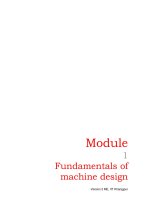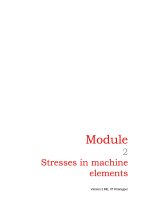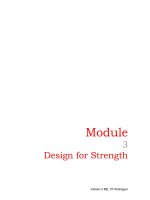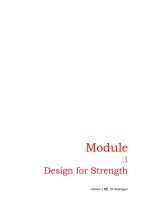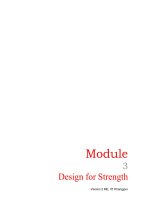Tài liệu Fundamentals of Machine Design P2 ppt
Bạn đang xem bản rút gọn của tài liệu. Xem và tải ngay bản đầy đủ của tài liệu tại đây (71.64 KB, 14 trang )
Version 2 ME, IIT Kharagpur
Module
1
Fundamentals of
machine design
Version 2 ME, IIT Kharagpur
Lesson
2
Engineering Materials
Version 2 ME, IIT Kharagpur
Instructional Objectives
At the end of this lesson, students should know
• Properties and applications of common engineering materials.
• Types and uses of ferrous metals such as cast iron, wrought iron and steel.
• Types and uses of some common non-ferrous metals.
• Types and uses of some non-metals.
• Important mechanical properties of materials.
1.2.1 Introduction
Choice of materials for a machine element depends very much on its properties,
cost, availability and such other factors. It is therefore important to have some
idea of the common engineering materials and their properties before learning
the details of design procedure. This topic is in the domain of material science or
metallurgy but some relevant discussions are necessary at this stage.
Common engineering materials are normally classified as metals and non-
metals. Metals may conveniently be divided into ferrous and non-ferrous metals.
Important ferrous metals for the present purpose are:
(i) cast iron (ii) wrought iron (iii) steel.
Some of the important non-ferrous metals used in engineering design are:
(a) Light metal group such as aluminium and its alloys, magnesium and
manganese alloys.
(b) Copper based alloys such as brass (Cu-Zn), bronze (Cu-Sn).
(c) White metal group such as nickel, silver, white bearing metals eg.
SnSb7Cu3, Sn60Sb11Pb, zinc etc.
Cast iron, wrought iron and steel will now be discussed under separate headings.
Version 2 ME, IIT Kharagpur
1.2.2 Ferrous materials
Cast iron- It is an alloy of iron, carbon and silicon and it is hard and brittle.
Carbon content may be within 1.7% to 3% and carbon may be present as free
carbon or iron carbide Fe
3
C. In general the types of cast iron are (a) grey cast
iron and (b) white cast iron (c) malleable cast iron (d) spheroidal or nodular cast
iron (e) austenitic cast iron (f) abrasion resistant cast iron.
(a) Grey cast iron- Carbon here is mainly in the form of graphite. This type of
cast iron is inexpensive and has high compressive strength. Graphite is an
excellent solid lubricant and this makes it easily machinable but brittle. Some
examples of this type of cast iron are FG20, FG35 or FG35Si15. The
numbers indicate ultimate tensile strength in MPa and 15 indicates 0.15%
silicon.
(b) White cast iron- In these cast irons carbon is present in the form of iron
carbide (Fe
3
C) which is hard and brittle. The presence of iron carbide
increases hardness and makes it difficult to machine. Consequently these
cast irons are abrasion resistant.
(c) Malleable cast iron- These are white cast irons rendered malleable by
annealing. These are tougher than grey cast iron and they can be twisted or
bent without fracture. They have excellent machining properties and are
inexpensive. Malleable cast iron are used for making parts where forging is
expensive such as hubs for wagon wheels, brake supports. Depending on the
method of processing they may be designated as black heart BM32, BM30 or
white heart WM42, WM35 etc.
(d) Spheroidal or nodular graphite cast iron- In these cast irons graphite is
present in the form of spheres or nodules. They have high tensile strength
and good elongation properties. They are designated as, for example,
SG50/7, SG80/2 etc where the first number gives the tensile strength in MPa
and the second number indicates percentage elongation.
(e) Austenitic cast iron- Depending on the form of graphite present these cast
iron can be classified broadly under two headings:
Austenitic flake graphite iron designated, for example, AFGNi16Cu7Cr2
Version 2 ME, IIT Kharagpur
Austenitic spheroidal or nodular graphite iron designated, for example,
ASGNi20Cr2. These are alloy cast irons and they contain small percentages
of silicon, manganese, sulphur, phosphorus etc. They may be produced by
adding alloying elements viz. nickel, chromium, molybdenum, copper and
manganese in sufficient quantities. These elements give more strength and
improved properties. They are used for making automobile parts such as
cylinders, pistons, piston rings, brake drums etc.
(f) Abrasion resistant cast iron- These are alloy cast iron and the alloying
elements render abrasion resistance. A typical designation is ABR33 Ni4 Cr2
which indicates a tensile strength in kg/mm
2
with 4% nickel and 2%
chromium.
Wrought iron- This is a very pure iron where the iron content is of the order of
99.5%. It is produced by re-melting pig iron and some small amount of silicon,
sulphur, or phosphorus may be present. It is tough, malleable and ductile and
can easily be forged or welded. It cannot however take sudden shock. Chains,
crane hooks, railway couplings and such other components may be made of this
iron.
Steel- This is by far the most important engineering material and there is an
enormous variety of steel to meet the wide variety of engineering requirements.
The present note is an introductory discussion of a vast topic.
Steel is basically an alloy of iron and carbon in which the carbon content can be
less than 1.7% and carbon is present in the form of iron carbide to impart
hardness and strength. Two main categories of steel are (a) Plain carbon steel
and (b) alloy steel.
(a) Plain carbon steel- The properties of plain carbon steel depend mainly on
the carbon percentages and other alloying elements are not usually present
in more than 0.5 to 1% such as 0.5% Si or 1% Mn etc. There is a large
variety of plane carbon steel and they are designated as C01, C14, C45,
C70 and so on where the number indicates the carbon percentage.



